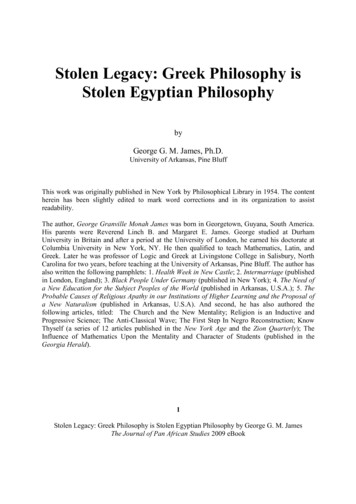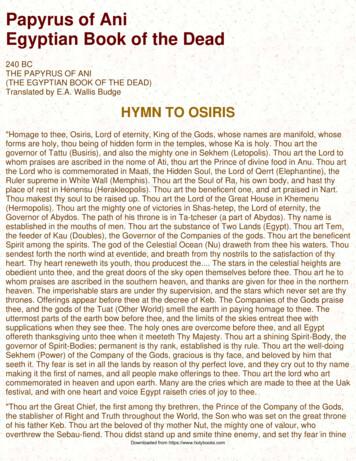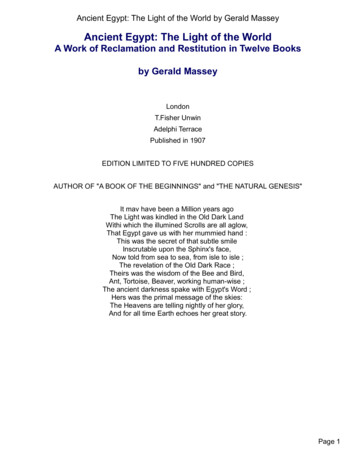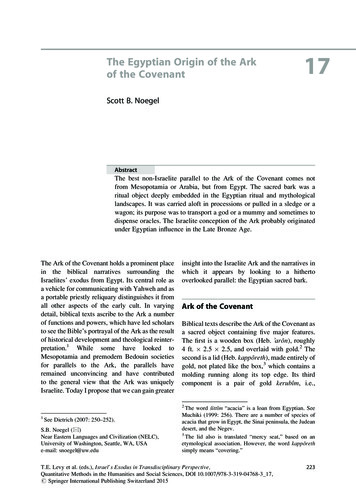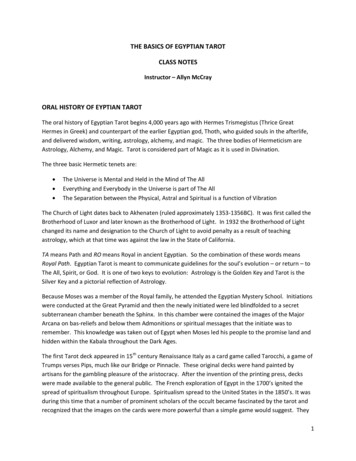
Transcription
History of EgyptianLanguage
Ancient EgyptianOldest and longest continually attestedworld language: 3250 BCE (oldesthieroglyphic writing)-1700s CE (Coptic)Afro-Asiatic family of languages“from Proto-Afroasiatic (PAA), Chadic was the firstto break off. Omotic and Cushitic followed theexample and split together, as did Egyptian, Berber,and Semitic in another group. Next, Egyptianfollowed by Berber split from the Semitic languages”(Bomhard and Kearns 1994:24)
Afro-Asiatic Family Originated in the northern part of Africa,the Arabian Peninsula, and some islandsand adjacent areas in Western Asia. 250 million speakers today AKA Hamito-Semitic, which is anobsolete term there is no linguistic entity“Hamitic” to be contrasted, as awhole, to “Semitic” Arguably somewhat racist3
Common Afro-Asiatic features pharyngeal fricatives (ħ and ʿ) Possible evidence that PAA was a tonal language Root-and-pattern morphology (consonants: Meaning of the word;vowels: grammatical information) Number is marked for singular, dual, and plural in many languages(including Egyptian) 2 genders: masculine and feminine Independent and suffix forms of personal pronouns4
Movement ofProto-Afroasiaticlanguage family5
There are interestingconnections betweenthe phonemes of PAAand PIE.6
Egyptian Language An extinct language of theNile valley7
Five main time periods of written Egyptian language:1. Old Egyptian (before 3000 to 2200 BCE)2. Middle Egyptian (c. 2200–c. 1600 BCE)3. Late Egyptian (c. 1550–c. 700 BCE)4. Demotic (c. 700 BCE–c. 400 CE)5. Coptic (c. 2nd century CE –17th century) The spoken dialects often differed considerablyThe first two are considerably differentfrom the last three grammatically.
A Bit About Coptic Coptic was the final stage ofAncient Egyptian before it died out Written in a script based onGreek alphabet A living language for 1500 years Only Egyptian script that showsvowelsWas unable to find a Coptic alphabet in IPA9
Sound Change
Egyptian Phonology Egyptian must be reconstructed imperfectly Egyptian scripts do not transcribe consonants exactly, and does notinclude vowels at all Writing systems remained constant while the phonological systemchanged considerably Coptic is 1600 years apart from Old and Middle Egyptian How? Compare to other Afro-Asiatic languages Egyptian spelling in Greek from the same time period Spelling of foreign words (Greek) in Egyptian11
Consonants in Egyptian
Sound Change Old Egyptian Coptic Fronting: consonants move from back of the mouthforward Example: Egyptian [q] Common Coptic [g] Often included palatalization13
Grammar
Grammatical Features: Old Egyptian and MiddleEgyptian primarily synthetic Verbs inflect for aspect, mood, dynamism (action vs. state), butnot tense Nouns inflect for gender, number (sg, du, pl), and definition(generic, defined, undefined) No case system15
Grammar Change Over Time: Old andMiddle Egyptian to Late Egyptian Many inflected verb forms dropped Less adjectives, more prepositional phrases (example: “bigbrother” “big one of brother”)16
Grammar Change Over Time: Late Egyptian to Coptic1. Synthetic analytic2. Analytic constructions turning into boundroot forms3. VSO SVO4. More specific verb forms for temporal andmodal references17
Dialect Variation Coptic had several notable dialects Upper: Sahidic, Akhmimic, Lycopolitan Lower: Bohairic, Fayyumic, Mesokemic Some morphological, phonetic, and lexicaldifferences, many vary in North-South pattern. Mostly vary by localised orthographic tradition, littlegrammatical differences.
Possible Coptic influence on Egyptian Arabic Grammar1. Word order in interrogative sentences Interrogative pronoun delayed in certain types of sentences,inconsistent with Classical Arabic (CA).2. Use of demonstrative pronoun to mark subject in non-verbalsentences No parallel in other Semitic languages, dialects of Arabic, etc. This particle is used in CA and other dialects of Arabic in manyenvironments but not in imperative sentences.3. Use of imperative particle/prefix mā4. Comparisons formed using comparative preposition after a regularadjective. 19Not very odd in Semitic languages, but appears to have Coptic asa contributing factor5. Use of ‘a pronoun affix verb as past tense marker
Coptic influence on Egyptian Arabic Vocabulary A number of Coptic lexical items have survived into Egyptian Arabic today. It is posited that many more remain, but are unrecognizable due tosignificant change, through metathesis or unpredictable sound change, oronly present in small fringe communities. These words come from a wide variety of topics, mainly vocabulary related toeveryday life (agriculture, animals, body, people, clothing, food, speech, tools,etc.) This being said, there are only about 100-200 confirmed loanwords fromCoptic. Turkish left more words in Egyptian Arabic than Coptic did.Note: Egyptian Arabic is NOT a daughter language of Ancient Egyptian/Coptic.EA only took on influence from Egyptian, much like English took influence fromFrench.20
The WritingSystem
First possible hieroglyphs?Gerzean (3500-3200 bc.) pottery found with drawingsthat resemble hieroglyphic writing, aged 3500-3200 bc.Suggests that Egyptian artistic tradition stronglyinfluenced hieroglyph formationEgyptian writing is thought to have come aboutbetween 3000-2900 bc.22
Writing SystemBoth phonetic (including alphabetic and syllabic)and logographic charactersLike in many writing systems, evolved over timeto become more abstract/conventional thaniconic.23
More on HieroglyphsHieroglyphs: comes from the Greek words hieros"sacred" glyphe "carving” Term first recorded in English in the 1580s3 components:1. Logograms (representing words)2. Phonograms (sounds)3. Determinatives (help to clarify words’meanings)
More on the Writing System Hieroglyphics (or a version) is thebasis for all Egyptian scripts exceptCoptic (based on Greek alphabet) Handwritten texts used hieratic Used for secular and literarytexts (vs. the language ofmonumental descriptions)25
The Decline of Hieroglyphs During the Ptolemaic (332-30 BCE) and the Roman Period (30BCE-395 CE), Greek and Roman culture became highlyinfluential Christianity started replacing traditional Egyptian religion, andChristianized Egyptians developed the Coptic alphabet Hieroglyphs were replaced by Coptic over time, and thelanguage was lost until the discovery of the Rosetta Stone26
Coptic Alphabet (First Egyptian Alphabetic writing system)27
The Rosetta Stone Found 15 July 1799 Contains the same message (aboutPtolemy V) in three scripts: hieroglyphs Demotic (Egyptian for dailypurposes) Ancient Greek Allowed historical linguists of thetime to “crack the code” anddecipher Egyptian hieroglyphs
Allen, J. P. (2013). The Ancient Egyptian Language: An Historical Study. Cambridge:Cambridge University Press.Crawford, C. D. (n.d.).Bishai, Wilson B. “Coptic Grammatical Influence on Egyptian Arabic.” Journal of theAmerican Oriental Society, vol. 82, no. 3, 1962, pp. 285–289. JSTOR,www.jstor.org/stable/597639. Accessed 9 Apr. 2020.Dalianis H. (2018) The History of the Patient Record and the Paper Record. In: ClinicalText Mining. Springer, ChamA Description of the Afro-Asiatic (Hamito-Semitic) Language Family. Retrieved April 9,2020, from rts/afro-asiatic.htmlEgyptian Hieroglyphs. Retrieved from https://www.ancient.eu/Egyptian Hieroglyphs/Everything you ever wanted to know about the Rosetta Stone. (n.d.). Retrieved lyphic (adj.). (n.d.). Retrieved haq, Emile. “Egyptian Arabic Vocabulary, Coptic Influence On.” Claremont CopticEncyclopedia, Macmillan, on/cce/id/1988.Lehmann, C. (n.d.). 2.1.1 Phonology. Retrieved languages antiquity/egypt/phon 1.htmlScoville, P. (2015, July 2).Satzinger, Helmut. “Dialectical Variation of the Egyptian-Coptic Language in the Courseof Its Four Millennia of Attested History.” Journal of the Canadian Society for CopticStudies, vol. 9, 2017, pp. 41–52.Sources
Greek alphabet A living language for 1500 years Only Egyptian script that shows vowels 9 Was unable to find a Coptic alphabet in IPA. Sound Change. . language was lost until the discovery of the Rosetta Stone 26. Coptic Alphabet (First Egyptian Alphabetic writing system) 27. The Rosetta Stone
